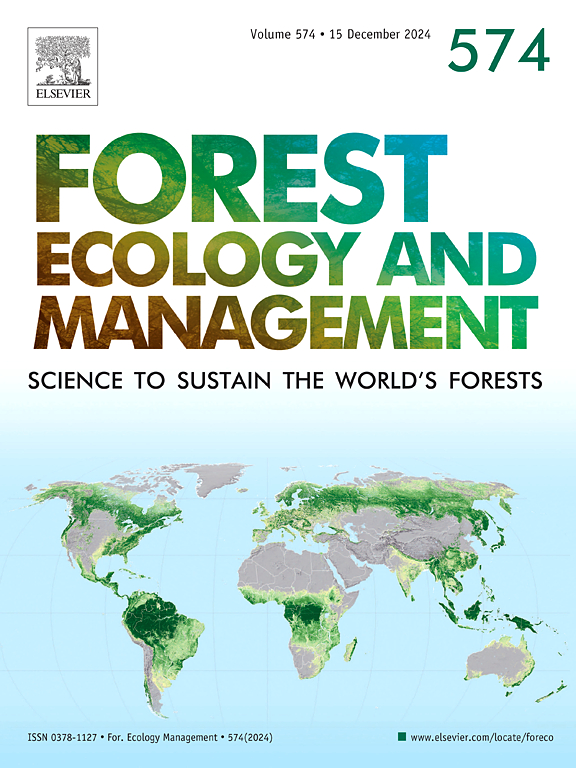Recovery of south-eastern Australian temperate forest carbon is influenced by post-fire drought as well as fire severity
IF 3.7
2区 农林科学
Q1 FORESTRY
引用次数: 0
Abstract
During 2017–2019 south-eastern Australia experienced intense drought that threatened and damaged ecosystems and helped enable the Black Summer wildfires of 2019–2020. These wildfires burnt through about 7 M ha of mainly temperate Eucalyptus forests, releasing the equivalent of Australia's total net annual greenhouse gas emissions. For the state of Victoria, these fires burnt through about 1 M ha of highly productive forests, where 50 % of the area was burnt with high to extreme wildfire severity. This study reports the recovery of Eucalyptus sieberi dominated forests three years after the Black Summer wildfires, and five years after prescribed burn applied in May 2018, during the drought. Wildfire affected sites were burnt with high and low-to-moderate severity, while previously prescribed burnt sites were burnt at low-to-moderate severity and were not reburnt in the 2020 wildfires. For wildfire affected sites, 30 % of small diameter trees (10–20 cm) continued to die three years after fires, irrespective of fire severity. Three years after wildfire, live tree carbon reached 92 % of pre-fire level for low-to-moderate severity sites and 76 % for high severity sites, indicating longer recovery with more severe wildfire. For prescribed burnt sites, tree mortality significantly increased two years after the burn and the number of live trees thereafter remained stable to five years post fire. This trend was reflected in the non-recovery of live tree carbon reaching only 95 % of pre-fire level five years after the burn. Recruitment of new Eucalyptus seedlings was observed in sites burnt in wildfire regardless of fire severity (900 ± 316 trees ha−1), but not in prescribed burnt sites. This was possibly driven by the differences in rainfall after fires, rather than fire type. For other forest carbon pools such as surface litter and CWD, recovery to pre-fire levels was observed within six months after fires. Moreover, for low-to-moderate severity burnt sites litter loads had doubled pre-fire mass three years after fire and continued to increase five years post fire.
Results from this study suggest that both fire severity and post-fire weather conditions play an important role in determining the rate of forest aboveground carbon recovery. Our findings indicate that as fire severity increases, the time required for recovery of live tree carbon to pre-fire level is longer. Even low impact prescribed burns during prolonged drought can lead to ongoing mortality that reduces the rate of carbon recovery. These observations indicate that increases in fire occurrence and severity associated with climate change can reduce the carbon carrying capacity of these highly productive temperate forests. The implication of this work is that the presumed recovery of aboveground carbon in forests following fires may be over-estimated or might not occur at all.
求助全文
约1分钟内获得全文
求助全文
来源期刊

Forest Ecology and Management
农林科学-林学
CiteScore
7.50
自引率
10.80%
发文量
665
审稿时长
39 days
期刊介绍:
Forest Ecology and Management publishes scientific articles linking forest ecology with forest management, focusing on the application of biological, ecological and social knowledge to the management and conservation of plantations and natural forests. The scope of the journal includes all forest ecosystems of the world.
A peer-review process ensures the quality and international interest of the manuscripts accepted for publication. The journal encourages communication between scientists in disparate fields who share a common interest in ecology and forest management, bridging the gap between research workers and forest managers.
We encourage submission of papers that will have the strongest interest and value to the Journal''s international readership. Some key features of papers with strong interest include:
1. Clear connections between the ecology and management of forests;
2. Novel ideas or approaches to important challenges in forest ecology and management;
3. Studies that address a population of interest beyond the scale of single research sites, Three key points in the design of forest experiments, Forest Ecology and Management 255 (2008) 2022-2023);
4. Review Articles on timely, important topics. Authors are welcome to contact one of the editors to discuss the suitability of a potential review manuscript.
The Journal encourages proposals for special issues examining important areas of forest ecology and management. Potential guest editors should contact any of the Editors to begin discussions about topics, potential papers, and other details.
 求助内容:
求助内容: 应助结果提醒方式:
应助结果提醒方式:


